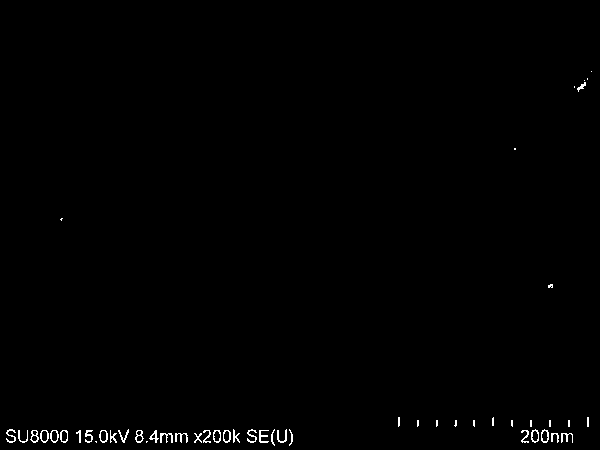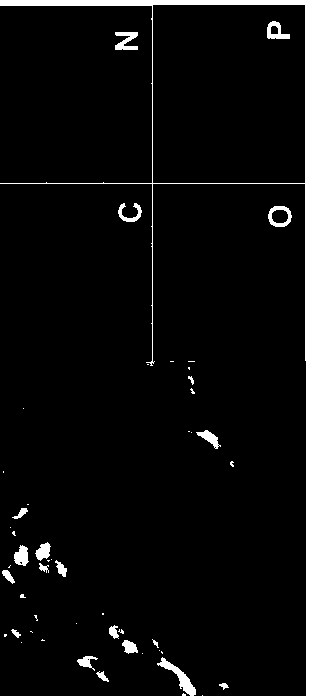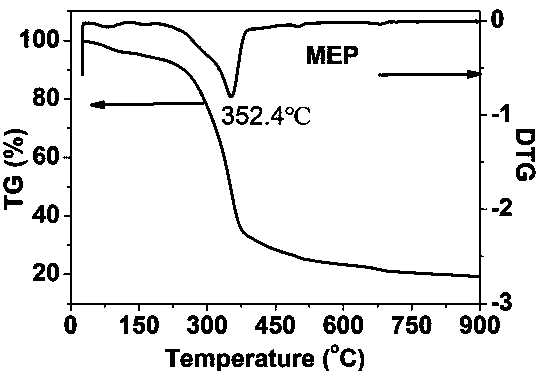Universal method for preparing hierarchical pore coexisting heteroatom doped carbon catalyst by using soft template agent, and applications of hierarchical pore coexisting heteroatom doped carbon catalyst
A technology of soft template agent and carbon catalyst, which is applied in chemical instruments and methods, catalyst activation/preparation, physical/chemical process catalysts, etc., to achieve the effects of increasing specific surface area, environmental friendliness, and improving conductivity
- Summary
- Abstract
- Description
- Claims
- Application Information
AI Technical Summary
Problems solved by technology
Method used
Image
Examples
Embodiment 1
[0031] Step S1: Grinding 1 g of Tachibana biomass in a glass mortar for 20 minutes to obtain material A1;
[0032] Step S2: Transfer material A1 to a nickel boat and place it in a tube furnace. In a nitrogen atmosphere with a flow rate of 100mL / min, first raise the temperature from room temperature to 330°C for 60 minutes and keep it for 120 minutes, and then increase the temperature at a rate of 3°C / min. Raise the temperature to 800°C and keep it for 120min, then naturally cool to room temperature to obtain material B1;
[0033] Step S3: Wash material B1 with 2M hydrochloric acid solution for 2-3 times and dry at 105°C for 12 hours to obtain the target product carbon catalyst C1, which is used as the cathode catalyst of the electro-Fenton degradation system to degrade 50mL of 10mg / L The degradation efficiency of methylene yellow solution was 65% after 60 minutes, and the time used for complete degradation was 120 minutes.
Embodiment 2
[0035] Step S1: Mix 1g of biomass Tachibana vine and 2g of soft templating agent C 10 h 18 K 2 N 2 o 10 Place in a glass mortar and grind for 20 minutes to obtain material A1;
[0036] Step S2: Transfer material A2 to a nickel boat and place it in a tube furnace. In a nitrogen atmosphere with a flow rate of 100mL / min, first raise the temperature from room temperature to 330°C for 60 minutes and keep it for 120 minutes, and then increase the temperature at a rate of 3°C / min. Raise the temperature to 800°C and keep it for 120min, then naturally cool to room temperature to obtain material B2;
[0037] Step S3: Wash material B2 with 2M hydrochloric acid solution for 2-3 times and dry at 105°C for 12 hours to obtain the target product carbon catalyst C2, which is used as the cathode catalyst of the electro-Fenton degradation system to degrade 50mL of 10mg / L The degradation efficiency of methylene yellow solution was 74% after 60 minutes, and the time used for complete degradat...
Embodiment 3
[0039] Step S1: Mix 1g of biomass Tachibana vine, 2g of soft templating agent C 10 h 18 K 2 N 2 o 10 and 0.5g dopant sodium hypophosphite were placed in a glass mortar and ground for 20 minutes to make it fully mixed to obtain material A3;
[0040] Step S2: Transfer material A3 to a nickel boat and place it in a tube furnace. In a nitrogen atmosphere with a flow rate of 100mL / min, first raise the temperature from room temperature to 330°C for 60 minutes and keep it for 120 minutes, and then increase the temperature at a rate of 3°C / min. Raise the temperature to 800°C and keep it for 120min, then naturally cool to room temperature to obtain material B3;
[0041] Step S3: Wash material B3 with 2M hydrochloric acid solution for 2-3 times and dry at 105°C for 12 hours to obtain the target product, phosphorus-doped carbon catalyst C3 with high electronegativity, which is used for electro-Fenton degradation The cathode catalyst of the system degrades 50mL of methylene yellow so...
PUM
| Property | Measurement | Unit |
|---|---|---|
| specific surface area | aaaaa | aaaaa |
Abstract
Description
Claims
Application Information
 Login to View More
Login to View More - R&D
- Intellectual Property
- Life Sciences
- Materials
- Tech Scout
- Unparalleled Data Quality
- Higher Quality Content
- 60% Fewer Hallucinations
Browse by: Latest US Patents, China's latest patents, Technical Efficacy Thesaurus, Application Domain, Technology Topic, Popular Technical Reports.
© 2025 PatSnap. All rights reserved.Legal|Privacy policy|Modern Slavery Act Transparency Statement|Sitemap|About US| Contact US: help@patsnap.com



